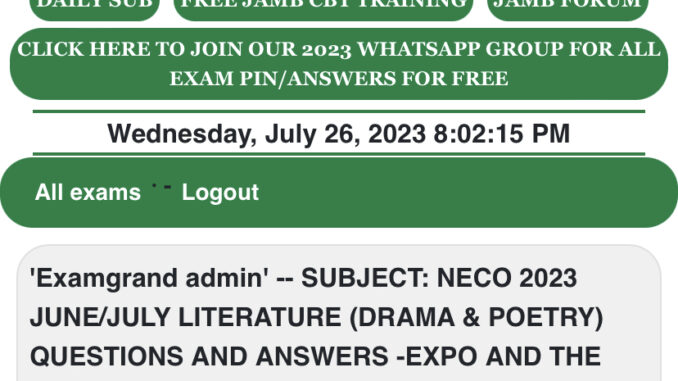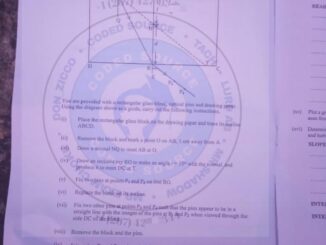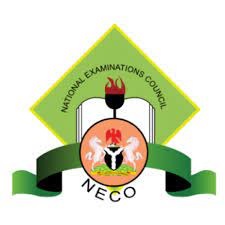
NECO 2023 LITERATURE QUESTION;-ExamgrandComNg !!!!!


=======================================
NECO 2023 LITERATURE DRAMA&POETRY) ANSWERS;-ExamgrandComNg !!!!!
INSTRUCTION: ANSWER ONE QUESTION FROM EACH SECTION.
=======================================================
SECTION 1
AFRICAN DRAMA
1.
In the play “Let Me Die Alone” by John Kargbo, Queen Yoko is a significant character whose role is pivotal to the story’s development. Queen Yoko is the ruling monarch of a fictional African kingdom and represents power, authority, and leadership. She provides wise counsel to her people, and she stands up for justice and fairness. Queen Yoko is also a strong advocate for the means of maintaining peace in her kingdom, even if it means engaging in military action. At the same time, she has a softer side, as she finds ways of reconciling and unifying her people after a particularly turbulent period of turmoil. Ultimately, Queen Yoko serves as a moral compass to the other characters in the play, and her role in the story is crucial.
=============================
2.
The theme of colonial oppression in the novel Let Me Die Alone is explored through the experiences of the protagonist, Jean-Claude. Jean-Claude is a young Haitian man living in the Caribbean island of La Gonave. He is the son of a poor fisherman and has been living in poverty since birth. He is constantly subjected to the harsh realities of colonial exploitation and oppression.
Jean-Claude’s life is a daily struggle as he faces the oppressive colonial system that has been in place for centuries. He is denied access to basic necessities such as food, clean water, and education. He is forced to work in grueling labor conditions and is paid very little. He is also subjected to racism and discrimination from the people in power.
The novel also illustrates the psychological effects of colonial oppression on Jean-Claude. He is constantly reminded of his status as an oppressed person and is filled with feelings of anger, resentment, and despair. He is unable to escape the oppressive system and is trapped in a cycle of poverty and marginalization.
The novel also examines the ways in which colonial oppression affects the entire community. The people of La Gonave are subjected to exploitation and violence from the colonial powers. They are denied basic rights and are treated as second-class citizens. The novel paints a vivid picture of the suffering and injustice faced by the people of La Gonave under colonial rule.
The novel Let Me Die Alone is a powerful exploration of the theme of colonial oppression. It highlights the daily struggles faced by the people of La Gonave and the psychological effects of oppression. The novel serves as a reminder of the injustices and suffering that people continue to face in the world today.
=============================
4.
In “The Lion and the Jewel,” Wole Soyinka explores the tradition of bride price and its significance within the Yoruba culture in Nigeria. The play delves into the conflict between modernity and tradition, highlighting the tension that arises from the clash between the two forces. In this play, bride price serves as a symbol of sacrifice and the power of tradition.
The village’s elders view bride price as an obligation to be upheld for a successful marriage. They emphasize the importance of bride price, arguing that it is a necessary tradition that implies respect for the woman and her family. The younger generation, on the other hand, regards it as a way to exploit women and deprive them of their freedom by forcing them to marry a particular suitor.
The protagonist Lakunle and his love interest Sidi are in disagreement about the significance of bride price in their relationship. While Lakunle considers the price an outrageous demand and argues for equal rights, Sidi views it as a sign of honor and respect for her family. This clash between tradition and modernity forms the core of the conflict in the play.
Ultimately, Soyinka is demonstrating how traditions can be a source of empowerment for women, and how they should not be considered a burden but rather embraced as a sign of respect. Bride price preserves the sanctity of marriage and symbolizes the commitment and devotion of both parties involved. This play challenges societal expectations of marriage and gender roles while honoring the importance of tradition in African culture.
=======================================================
SECTION II
NON-AFRICAN DRAMA*
5.
In John Osborne’s play, “Look Back In Anger,” innocence is indeed a major theme that runs throughout the narrative. The play explores the loss of innocence and the harsh realities of life as experienced by the main character, Jimmy Porter, and those around him. The play follows Jimmy’s journey from innocence to bitterness as he is thrust into a world of emotional and financial struggles. He also questions the values of societal norms, which can further be seen as a loss of his innocence.
The contrast between innocent Jimmy and the more hardened version of him is where the play really focuses, and it is through this exploration of his journey that Osborne conveys the bleakness of the realities of life.
============================
6.
Jimmy Porter is the central character of John Osborne’s play “Look Back in Anger.” He is a complex and multifaceted character who represents the restlessness and discontent of the working-class post-war generation in Britain.
Jimmy is a passionate and intelligent man, full of energy and ideas. He yearns to change his mundane life at the bottom of the social ladder. His job as a market porter does not provide him with an opportunity to express his creative potential, and he seeks fulfillment by engaging in political discussions and debates.
Jimmy is presented as a “angry young man” – a bitter, disillusioned yet articulate figure who rails against the conventions and class system of post-war Britain. Although capable of great sensitivity and depth, Jimmy’s frustration often leads to outbursts of anger directed at his wife, Alison. His angry tirades can be seen as a defence mechanism, protecting him from the thought that his hopes of a better life will never be fulfilled. The play presents Jimmy as a deep thinker capable of generating compassion and understanding but unable to find peace or contentment in his own life.
==============================
7.
In “Fences” by August Wilson, the theme of parental irresponsibility is explored through the character of Troy Maxson. As a father, husband, and head of the household, Troy exhibits various behaviors and attitudes that reflect his lack of responsibility. He refuses to accept responsibility for his past mistakes, turning away from his family and ignoring their needs. He is an alcoholic who eventually abandons his family and creates a wedge between himself and them. He also neglects to provide financially, pushing the responsibility of the household onto his son. Troy is unable to accept his role as a father and instead allows his anger and misdeeds to get in the way of a meaningful relationship. Ultimately, Troy’s inability to be a responsible parent leads to the emotional destruction of his family. The message of the play is that parental responsibility is paramount to allowing children to have a chance at a successful future.
============================
8
i. Rose Maxson: Rose Maxson is one of the central characters in August Wilson’s play “Fences.” She is the wife of Troy Maxson, and is portrayed as a strong and resilient woman.
Rose’s character is defined by her commitment to her family and her selfless devotion to her husband, despite his infidelity and neglect. Rose is forced to confront her husband’s shortcomings and deal with the repercussions of his failed dreams. She is ultimately presented as a source of hope in a world of despair and chaos. Despite her struggles, Rose remains unbowed and determined, offering insight into the power of unconditional love.
ii. Cory Maxson : Cory Maxson is a central character in the play “Fences” written by August Wilson. He is the high school-aged son of Troy and Rose Maxson, and his character serves as an important reflection of the complexities of parental relationships, generational conflict, and a desire to break from tradition. He strives to find his place in the world, facing opposition from his father while trying to pursue his dream of becoming a football player. Cory also serves as an example of how individuals can be shaped by their experiences, adversity, and expectations.
===========================
LITERATURE II ANSWERS
SECTION C
_(Answer ONE Question from this section)_
(9)
The Grieved Lands of Africa” by Agostinho Neto is a poignant and emotionally charged poem that addresses the suffering, oppression, and resilience of Africa and its people. The poem delves into the historical and contemporary injustices faced by the continent, while also celebrating the enduring spirit and unity of its people.
Tone: The tone of the poem is one of sorrow, grief, and lamentation. The title itself, “The Grieved Lands of Africa,” sets the somber tone for the entire poem. The poet paints a picture of the hardships endured by Africa, referencing slavery, degradation, and oppression. The repetition of “grieved” throughout the poem emphasizes the weight of suffering borne by the continent and its people.
Mood: The mood of the poem is both sorrowful and hopeful. While it acknowledges the deep pain and injustice faced by Africa, there is also a sense of resilience and hope that shines through. The poem celebrates the enduring spirit of Africa and its people, emphasizing their vitality and the richness of their culture. The mention of dreams, dances, and the sound of life alludes to the indomitable spirit of the continent, despite its history of suffering.
===================================================
(10)
The Leader and the Led is an allegorical poem. Hence, it can be understood at two levels of meaning. The poem makes use of animal characters to illustrate human conditions. The poem dramatises a situation where different animals vie for leadership positions, but are judged by other animals to be unqualified because of certain negative attributes that they possess. For instance, the Lion is seen to be ‘ferocious’ in his dealings with other animals. In other words, the Lion’s anger and oppressive tendencies disqualify him from being an ideal leader. Other animals who aspire to the leadership of the jungle are the Hyena, the Giraffe, the Zebra, the Elephant, the Warthog and the Rhino. Each of these aspirants is seen to have one or two negative attributes that disqualify them from being leaders.
In other words, they have their excesses and these do not make for the ideal leadership that the animals are glamouring for. For instance, the Hyena’s ‘lethal appetite’ is what detracts from his leadership abilities. The Giraffe is seen to be high up there, which means that he might not be in tune with the real experiences of the masses. The Zebra is seen not to be an honest and straightforward person. The elephant is feared for its gigantic feet which could easily crush the lesser creatures. The Warthog has an ugly character while the Rhino is seen to be too violent to be a good leader.
In the ending stanza, it is revealed that a good leader is one who has ‘a hybrid of habits’.
This is further explained in the next stanza:
‘A little bit of a Lion/A little bit of a Lamb’.
This means that leaders should have
dynamic, unpredictable but virtuous qualities.
Again, the poem implies that leaders should acknowledge the fact that they derive their value from the followers, as it is the followers that enthrone leaders.
COMPLETED!!!
=======================================
CLICK HERE TO JOIN OUR TELEGRAM CHANNEL FOR ALL 2023 EXAM ANSWERS FOR FREE





Be the first to comment